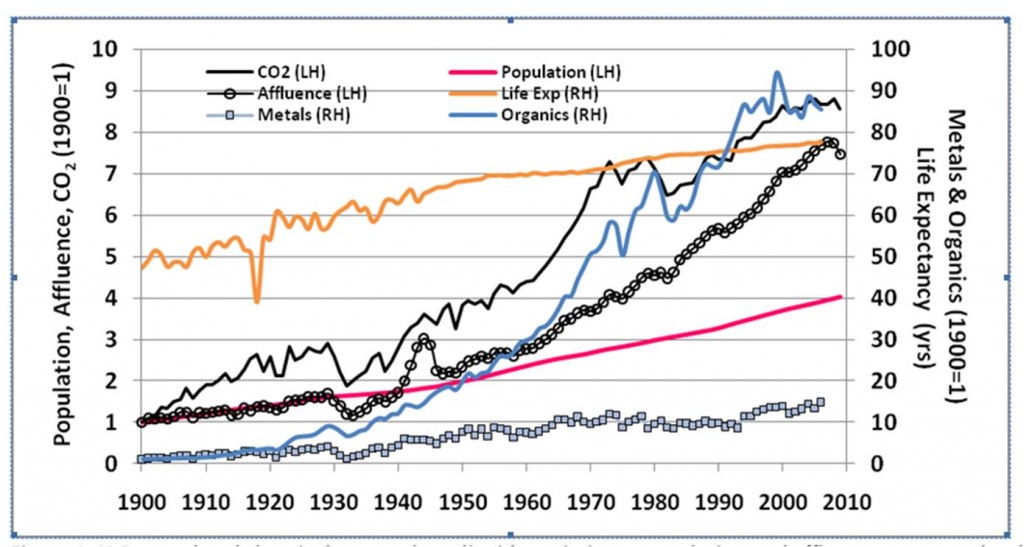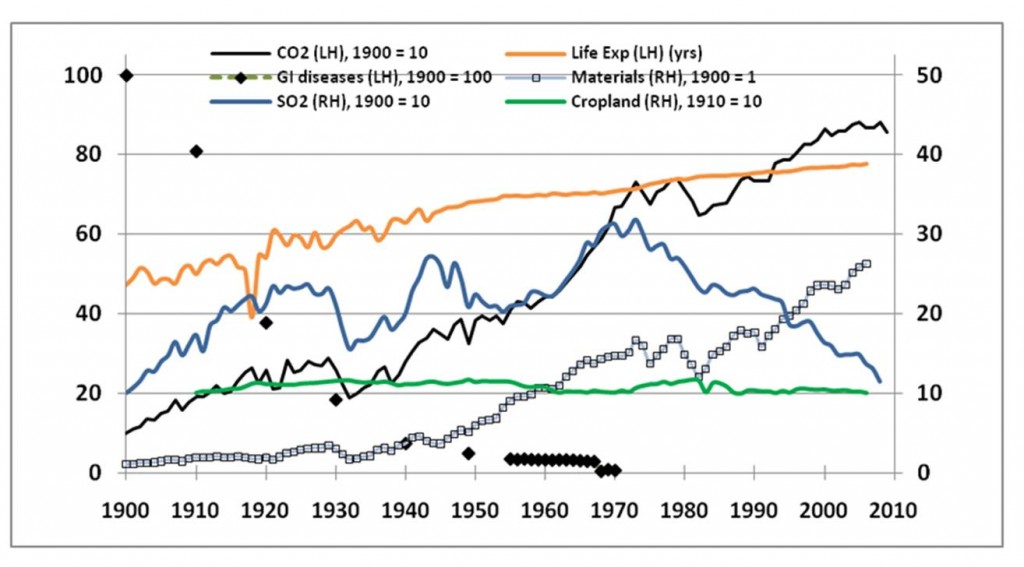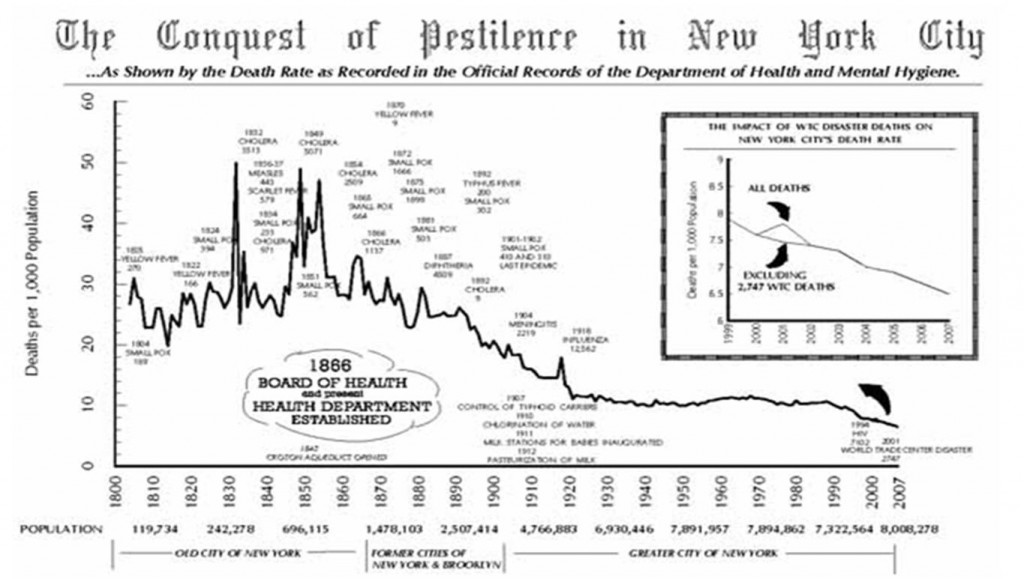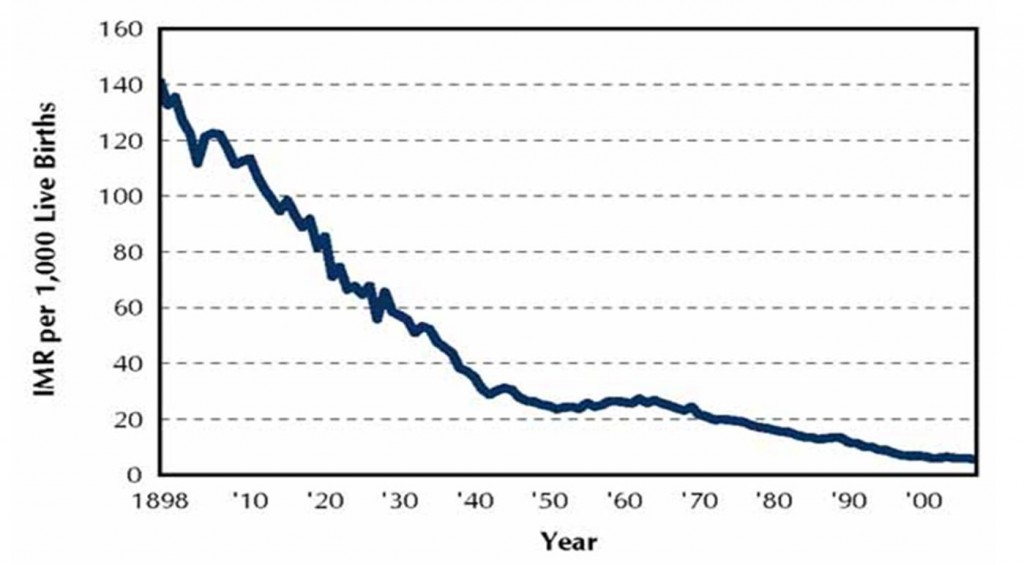Population, Consumption, Carbon Emissions, and Human Well-Being in the Age of Industrialization (Part III — Have Higher US Population, Consumption, and Newer Technologies Reduced Well-Being?)
By Indur Goklany -- April 24, 2010Editor’s note: In Part III of this four-part series, Indur M. Goklany applies the general analyses of Part I and Part II to the impact of U.S. industrialization on human well-being and environmental improvement.
In my previous post I showed that, notwithstanding the Neo-Malthusian worldview, human well-being has advanced globally since the start of industrialization more than two centuries ago, despite massive increases in population, consumption, affluence, and carbon dioxide emissions. In this post, I will focus on long-term trends in the U.S. for these and other indicators.
Figure 1 shows that despite several-fold increases in the use of metals and synthetic organic chemicals, and emissions of CO2 stoked by increasing populations and affluence, life expectancy, the single best measure of human well-being, increased from 1900 to 2006 for the US. Figure 1 reiterates this point with respect to materials use.

Figure 1: U.S. metal and chemical use, carbon dioxide emissions, population and affluence compared to life expectancy, 1900–2006. Metals and chemical use exclude their content in imported goods. Sources: Matos (2009), CDIAC (2009), Maddison (2010), US Bureau of the Census (2010).
These figures indicate that since 1900, U.S. population has quadrupled, affluence has septupled, their product (GDP) has increased 30-fold, synthetic organic chemical use has increased 85-fold, metals use 14-fold, material use 25-fold, and CO2 emissions 8-fold. Yet life expectancy advanced from 47 to 78 years.
Figure 2 shows that during the same period, 1900–2006, emissions of air pollution, represented by sulfur dioxide, waxed and waned. Food and water got safer, as indicated by the virtual elimination of deaths from gastrointestinal (GI) diseases between 1900 and 1970. Cropland, a measure of habitat converted to human uses — the single most important pressure on species, ecosystems, and biodiversity — was more or less unchanged from 1910 onward despite the increase in food demand.
For the most part, life expectancy grew more or less steadily for the U.S., except for a brief plunge at the end of the First World War accentuated by the 1918-20 Spanish flu epidemic. As in the rest of the world, today’s U.S. population not only lives longer, it is also healthier. The disability rate for seniors declined 28 percent between 1982 and 2004/2005 and, despite quantum improvements in diagnostic tools, major diseases (e.g., cancer, and heart and respiratory diseases) now occur 8–11 years later than a century ago.

Figure 2: U.S. material use, carbon dioxide emissions, sulfur dioxide emissions, habitat converted to cropland, and deaths from gastrointestinal (GI) diseases compared to life expectancy, 1900–2008. Sources: Matos (2009), CDIAC (2009), US Bureau of the Census (2010), Goklany (2007, 2009).
Consistent with this, data for New York City indicate that — despite a population increase from 80,000 in 1800 to 3.4 million in 1900 and 8.0 million in 2000 and any associated increases in economic product, and chemical, fossil fuel and material use that, no doubt, occurred —crude mortality rates have declined more or less steadily since the 1860s (again except for the flu epidemic). Figures 3 and 4 show, once again, that whatever health-related problems accompanied economic development, technological change, material, chemical and fossil fuel consumption, and population growth, they were overwhelmed by the health-related benefits associated with industrialization and modern economic growth.

Figure 3: Death Rates (deaths per 1,000 population), New York City, c. 1800-2007. Source: NYC Department of Health & Mental Hygiene, Summary of Vital Statistics (2008). H/T to William Briggs for making me aware of this figure. This figure shows a stylized transition for mortality rate in the middle third of the 19th century consistent with the Environmental Transition Hypothesis
.
This does not mean that fossil fuel, chemical and material consumption have zero impact, but it means that overall benefits have markedly outweighed costs.

Figure 4: Infant Mortality Rate (deaths per 1,000 live births), New York City, 1898-2007. In 1898 IMR was estimated to be 140.9. Because of incomplete reporting of early neonatal deaths, this is almost certainly an underestimate. In 2007 IMR was 5.4 deaths per 1,000 live births. Source: NYC Department of Health & Mental Hygiene, Summary of Vital Statistics (2008)
The reductions in rates of deaths and diseases since at least 1900 in the US, despite increased population, energy, and material and chemical use, belie the Neo-Malthusian worldview. The improvements in the human condition can be ascribed to broad dissemination (through education, public health systems, trade and commerce) of numerous new and improved technologies in agriculture, health and medicine supplemented through various ingenious advances in communications, information technology and other energy powered technologies (see here for additional details). The continual increase in life expectancy accompanied by the decline in disease during this period (as shown by Figure 2) indicates that the new technologies reduced risks by a greater amount than any risks that they may have created or exacerbated due to pollutants associated with greater consumption of materials, chemicals and energy,
And this is one reason why the Neo-Malthusian vision comes up short. It dwells on the increases in risk that new technologies may create or aggravate but overlooks the larger — and usually more certain — risks that they would also eliminate or reduce. In other words, it focuses on the pixels, but misses the larger picture, despite pretensions to a holistic worldview.
It was this mindset — legitimized as the “precautionary principle” — that led, for instance, to the premature reduction in DDT usage even in areas where malaria was endemic and could be reduced through its use. See here and here.
In my next post, I will look at the root causes as to why empirical trends have failed to follow a path consistent with the Neo-Malthusian worldview.
Humanity confronts what I call the paradox of improvement. When you begin to improve a business process, the outcomes from picking the low hanging fruit are impressive. Once you’ve captured those, improvement becomes much harder. My rule of thumb is that 80% of your increase in results is related to 20% of your effort. Once you’ve accomplished that project, improving the last 20% is 4 times as expensive and comes in very small increments. We have tripled the fuel economy of the average sedan since 1970. Now the government has mandated an increase to 36 MPG. That next six miles per gallon will cost 4 or 5 times more than the initial improvement.
What we lack today is mature leadership. Men and women at the forefront of society who are willing to explain the constraints we face. There are no magic cost free solutions. There is only steady incremental progress. We have a political/academic elite convinced that stating a desired outcome is equivalent to developing and implementing a solution.
The other 95% of us live in a world where human ingenuity and the ability to integrate information leads to incremental improvement and the occasional breakthrough. The future might not be so bright that we have to wear shades, but the future is certainly brighter than the past.
Any idea why affluence dropped of a bit at the end of World War II?
Andrew,
Two reasons for the drop off in GDP per capita in the mid- to late-1940s: First, the US had two recessions — in 1945 and 1949. Second, the baby boom had started. So the numerator (GDP) went down, and the denominator (capita) went up.
The ending of the war may have something to do with the 1945 recession, I suspect.
I teach environmental engineering, and I would very much appreciate a reference for Figure 3.
Bob Sykes
NYC Department of Health & Mental Hygiene, Summary of Vital Statistics (2008). A later version is available at: http://www.nyc.gov/html/doh/downloads/pdf/vs/2008sum.pdf
Steve C:
Thanks for sharing this insightful commentary.
The main problem with energy is the Politics that is being played on both sides of the story. Take a look at Ky Att. General Jack Conway for being in bed with big energy at the expense of his own integrity.http://jacksconflictofinterest.blogspot.com/
This blog is perfect for the chronic anthropecentric, human exceptionalist in you. Forget the morality of preserving Earth for other species, after all its only us that matter.
crying in my rooibos,
You don’t get it, but wealthier people are more willing and able to preserve the earth for other species. That’s what the data show. So wealth not only advances human well-being, but it also creates the conditions whereby people are more willing to care for the rest of nature. That’s what the “environmental transition hypothesis” is about. Check out, for instance, http://www.ejsd.org/docs/HAVE_INCREASES_IN_POPULATION_AFFLUENCE_AND_TECHNOLOGY_WORSENED_HUMAN_AND_ENVIRONMENTAL_WELL-BEING.pdf
[…] offer some reasons in the last of a series of posts (1, 2, 3, 4) at […]
[…] Read this article […]